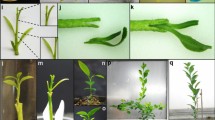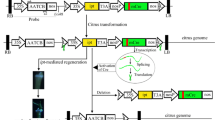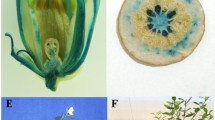Abstract
Key message
We have defined the conditions for citrus transformations using glyphosate as selection agent. This protocol results in high transformation rate and low incidence of chimeric shoots.
Abstract
Glyphosate, the most widely used herbicide in the world, specifically inhibits 5-enolpyruvylshikimate-3-phosphate synthase (EPSPS), an essential enzyme of the shikimate pathway. Various laboratory-generated or naturally evolved glyphosate-resistant EPSPS variants have been used to produce glyphosate-tolerant transgenic crops, enabling highly effective weed control in agriculture. In this study, we explored the potential of using a citrus EPSPS variant that mimics the previously reported Eleusine indica glyphosate-resistant TIPS (T102I + P106S) mutant for selection of transgenic citrus plants in the presence of glyphosate. We found that glyphosate did not suppress bud formation on ‘Duncan’ grapefruit seedling explants, but inhibited non-transgenic bud outgrowth to produce shoots in a concentration-dependent manner. At certain concentrations, glyphosate had dramatic effect on the transformation rate and the percentage of non-chimeric transgenic shoots in this newly developed selection system. Specifically, at 0, 10, 20, and 50 μM of glyphosate, the citrus TIPS EPSPS-based selection resulted in transformation rates of 4.02, 5.04, 14.46, and 40.78%, respectively, and 6.41, 23.96, 42.94, and 40.17% of non-chimeric transgenic shoots, respectively. These results indicate that the citrus TIPS EPSPS-glyphosate selection system is highly efficient and can be used as an alternative to antibiotic-based selection methods in citrus genetic transformation. Furthermore, the selection conditions defined in this study are expected to greatly facilitate the production of genetically modified, market-friendly citrus plants, such as cisgenic and intragenic plants.





Similar content being viewed by others
Availability of data and material
The constructs used in this study are available upon request from the corresponding author Zhonglin Mou (zhlmou@ufl.edu).
Code availability
Not applicable.
References
Alvarez-Gerding X, Espinoza C, Inostroza-Blancheteau C, Arce-Johnson P (2015) Molecular and physiological changes in response to salt stress in Citrus macrophylla W plants overexpressing Arabidopsis CBF3/DREB1A. Plant Physiol Biochem 92:71–80. https://doi.org/10.1016/j.plaphy.2015.04.005
An C, Orbović V, Mou Z (2013) An efficient intragenic vector for generating intragenic and cisgenic plants in citrus. Am J Plant Sci 4:2131–2137
Bachchu MA, Jin SB, Park J-W, Boo K-B, Sun H-J, Kim Y-W, Lee H-Y, Riu K-Z, Kim J-H (2011) Functional expression of Miraculin, a taste-modifying protein, in transgenic Miyagawa Wase Satsuma Mandarin (Citrus unshiu Marc.). J Korean Soc Appl Biol Chem 54:24–29
Ballester A, Cervera M, Pena L (2010) Selectable marker-free transgenic orange plants recovered under non-selective conditions and through PCR analysis of all regenerants. Plant Cell Tissue Org Cult 102:329–336
Clough SJ, Bent AF (1998) Floral dip: a simplified method for Agrobacterium-mediated transformation of Arabidopsis thaliana. Plant J 16:735–743
Dutt M, Lee DH, Grosser JW (2010) Bifunctional selection-reporter systems for genetic transformation of citrus: mannose and kanamycin based systems. Vitro Cell Devel Biol Plant 46:467–476
Fagoaga C, López C, de Mendoza AH, Moreno P, Navarro L, Flores R, Peña L (2006) Post- transcriptional gene silencing of the p23 silencing suppressor of Citrus tristeza virus confers resistance to the virus in transgenic Mexican lime. Plant Mol Biol 60:153–165
Fagoaga C, Rodrigo I, Conejero V, Hinarejos C, Tuset JJ, Arnau J, Pina JA, Navarro L, Peña L (2001) Increased tolerance to Phytophthora citrophthora in transgenic orange plants constitutively expressing a tomato pathogenesis related protein PR-5. Mol Breed 7:175–185
Funke T, Han H, Healy-Fried ML, Fischer M, Schonbrunn E (2006) Molecular basis for the herbicide resistance of roundup ready crops. Proc Natl Acad Sci USA 103:13010–13015
Hao G, Stover E, Gupta G (2016) Overexpression of a modified plant thionin enhances disease resistance to citrus canker and huanglongbing (HLB). Front Plant Sci 7:1078
Hao G, Zhang S, Stover E (2017) Transgenic expression of antimicrobial peptide D2A21 confers resistance to diseases incited by Pseudomonas syringae pv. tabaci and Xanthomonas citri, but not Candidatus Liberibacter asiaticus. PLoS ONE 12:e0186810
Klimazsewska K, Cheliak WM (1987) Selection for glyphosate-tolerant cell cultures in poplar. In: Proceedings of the IAE task II meeting and workshops on cell cultures and coppicing, pp17–23
Koca U, Berhow MA, Febres VJ, Champ KI, Carrillo-Mendoza O, Moore GA (2009) Decreasing unpalatable flavonoid components in Citrus: the effect of transformation construct. Phys Plant 137:101–114
Mondal S, Dutt M, Grosser J, Dewdney M (2012) Transgenic citrus expressing the antimicrobial gene Attacin E (attE) reduces the susceptibility of ‘Duncan’ grapefruit to the citrus scab caused by Elsinoë fawcettii. Eur J Plant Pathol 133:391–404
Murashige T, Skoog F (1962) A revised medium for rapid growth and bio assays with tobacco tissue cultures. Physiol Plant 15:473–497
National Academies of Science, Engineering and Medicine (2018) A review of the citrus greening research and development efforts supported by the citrus research and development foundation: fighting a ravaging disease. The National Academies Press
Orbović V, Grosser JW (2015) Citrus transformation using juvenile tissue explants. Methods Mol Biol 1224:245–257
Orbović V, Fields J, Syvertsen J (2017) Transgenic citrus plants expressing p35 anti-apoptotic gene have altered response to abiotic stress. Hortic Environ Biotechnol 58:33–39
Padgette SR, Kolacz KH, Delannay X, Re DB, LaVallee BJ, Tinius CN, Rhodes WK, Otero YI, Barry GF, Eichholz DA, Peschke VM, Nida DL, Taylor NB, Kishore GM (1995) Development, identification, and characterization of glyphosate-tolerant soybean line. Crop Sci 35:1451–1461
Peng A, Xu L, He Y, Lei T, Yao L, Chen S, Zou X (2015) Efficient production of marker-free transgenic ‘Tarocco’ blood orange (Citrus sinensis Osbeck) with enhanced resistance to citrus canker using a Cre/loxP site-recombination system. Plant Cell Tiss Organ Cult 123:1–13
Pollegioni L, Schonbrunn E, Siehl D (2011) Molecular basis of glyphosate resistance: different approaches through protein engineering. FEBS J 278:2753–2766
Singh A, Joshi M, Devi EL (2015) Alternative to transgenesis: cisgenesis and intragenesis. In: Al-Khayri J, Jain S, Johnson D (eds) Advances in plant breeding strategies: breeding, biotechnology and molecular tools. Springer, Cham
Sinn J, Held J, Vosburg C, Klee S, Orbović V, Taylor E, Gottwald T, Stover E, Moore G, McNellis T (2020) Flowering locus T chimeric protein induces floral precocity in edible citrus. Plant Biotech J19:215–217
Song G, Prieto H, Orbović V (2019) Agrobacterium-mediated transformation of tree fruit crops: methods, progress, and challenges. Front Plant Sci 10:226
Spencer M, Mumm R, Gwyn J, inventors; DeKalb Genetics Corporation, assignee. (2000) Glyphosate resistant maize lines. U.S. patent 6040497
Steinrucken HC, Amrhein N (1980) The herbicide glyphosate is a potent inhibitor of 5-enolpyruvylshikimic acid-3-phosphate synthase. Biochem Biophys Res Commun 94:1207–1212
Wu H, Acanda Y, Canton M, Zale J (2019) Efficient biolistic transformation of immature citrus rootstocks using phosphomannose-isomerase selection. Plants 8:390. https://doi.org/10.3390/plants8100390
Yau Y, Stewart CN (2013) Less is more: strategies to remove marker genes from transgenic plants. BMC Biotech 13:36
Yu Q, Jalaludin A, Han H, Chen M, Sammons RD, Powles SB (2015) Evolution of a double amino acid substitution in the 5-enolpyruvylshikimate-3-phosphate synthase in Eleusine indica conferring high-level glyphosate resistance. Plant Physiol 167:1440–1447
Zhang X, Francis MI, Dawson WO, Graham JH, Orbović V, Triplett EW, Mou Z (2010) Overexpression of the Arabidopsis NPR1 gene in citrus increases resistance to citrus canker. Eur J Plant Pathol 128:91–100
Zou X, Jiang X, Xu L, Lei T, Peng A, He Y, Yao L, Chen S (2017) Transgenic citrus expressing synthesized cecropin B genes in the phloem exhibits decreased susceptibility to Huanglongbing. Plant Mol Biol 93:341–353
Funding
This research was supported by the USDA/NIFA Emergency Citrus Disease Research and Extension Program.
Author information
Authors and Affiliations
Contributions
ZM and VO conceived and designed research, and analyzed data. BM and XZ conducted the experiments and analyzed data. VO and ZM wrote the manuscript. ET conceived research and reviewed the manuscript. All authors read and approved the manuscript.
Corresponding authors
Ethics declarations
Conflict of interest
Authors declare no conflict of interest.
Ethics approval
Not applicable.
Consent to participate
Not applicable.
Consent for publication
Not applicable.
Additional information
Communicated by Kan Wang.
Publisher's Note
Springer Nature remains neutral with regard to jurisdictional claims in published maps and institutional affiliations.
Supplementary Information
Below is the link to the electronic supplementary material.
Rights and permissions
About this article
Cite this article
Merritt, B.A., Zhang, X., Triplett, E.W. et al. Selection of transgenic citrus plants based on glyphosate tolerance conferred by a citrus 5-enolpyruvylshikimate-3-phosphate synthase variant. Plant Cell Rep 40, 1947–1956 (2021). https://doi.org/10.1007/s00299-021-02760-y
Received:
Accepted:
Published:
Issue Date:
DOI: https://doi.org/10.1007/s00299-021-02760-y




